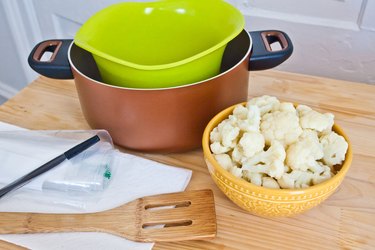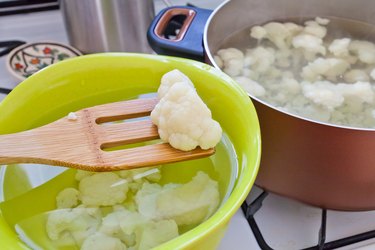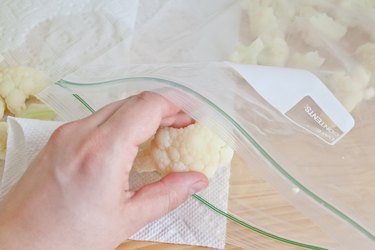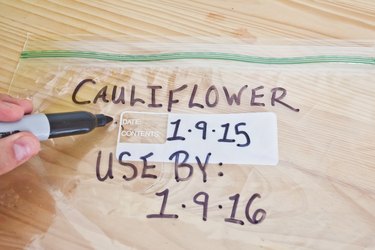
A bountiful harvest of cauliflower can last through winter if you freeze the surplus. Proper freezing practices retain much of vegetables' texture and flavor, making frozen cauliflower the next best thing to fresh. The enzyme action that causes cauliflower to grow is the same action that causes it to rot, but you can stop this enzyme action by blanching or steaming the cauliflower before freezing.
Blanching and Steaming
Video of the Day

Similar techniques, blanching and steaming partially cook the cauliflower and stop the enzyme action. For blanching, the cauliflower is plunged in a bath of boiling water, while the vegetables are suspended a few inches above boiling water for steaming. Cut the cauliflower head into small florets. Work in small batches, adding no more to the pan than can fit in a single layer, usually 1 to 2 cups. Blanch submerged cauliflower for about 3 minutes or until tender-crisp. Steamed cauliflower takes 1 1/2 times longer, so remove after 4 1/2 minutes. Steamers have basket to easily remove the cauliflower, but it also helps to use a basket when blanching. Otherwise, remove the blanched cauliflower with a spider spoon.
Video of the Day
Cooling

Hot cauliflower continues to cook after removing it from the pot, which can result in mushy, flavorless cauliflower. Retain the flavor and prevent overcooking by transferring the cauliflower immediately to a bowl of cold or icy water. Add approximately 1 pound of ice for every pound of cauliflower. Change the water frequently as the hot cauliflower raises the temperature. Remove the cauliflower after about 3 minutes or when you notice a significant temperature drop. Drain well on paper towel or kitchen towels to remove excess water, reducing ice crystal formation that can break down the cell walls and make cauliflower mushy.
Packing

The best packing method depends on how you plan to use the frozen cauliflower. Dry packing works best when you'll make an entire package of cauliflower at once. Add the cooled cauliflower directly to freezer bags or freezer-proof plastic storage containers, leaving about 1/2 inch of headspace to the top. Remove as much air as possible before sealing -- oxygen in the container or bag causes freezer burn. If you prefer to remove individual cauliflower florets as you need them, tray packing prevents cauliflower from freezing together in a solid mass. Spread the florets on trays with space between each piece. Place the tray in the freezer for at least one hour or until frozen. Pack the cauliflower into freezer bags or containers as you would with dry packing.
Storage

Carefully label each package of cauliflower with the packaging date so you can eat older foods first and keep track of freshness. When properly blanched, cooled and packed, cauliflower can be frozen for 12 to 18 months. You might find it helpful to include the "best by" date on the packages as well. Flavor and texture retention depends on freezing the cauliflower as quickly as possible. Never attempt to freeze more food than can freeze solid within 24 hours, usually 2 to 3 pounds of food per cubic foot of freezer space. For best results, add the packages along the freezer walls so they freeze fast. Leave an inch or two between each package to allow the cold freezer air to circulate around all sides. Redistribute the packages throughout the freezer after 24 hours.